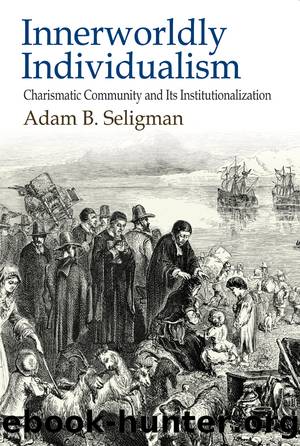Innerworldly Individualism by Adam B. Seligman

Author:Adam B. Seligman [Seligman, Adam B.]
Language: eng
Format: epub
Tags: Social Science, Sociology, General
ISBN: 9781351512404
Google: Bx4uDwAAQBAJ
Publisher: Routledge
Published: 2017-07-12T03:27:00+00:00
Notes
1. The effect of developments in England on New England is noted in The Winthrop Papers, vol. 4, 205.
2. Williston Walker, ed., The Creeds and Platforms of Congregationalism (Boston: The Pilgrim Press, 1960), 132â48, 157â237.
3. Thomas Barnes, ed., The Book of the General Lawes and Libertyes Concerning the Inhabitants of Massachusetts (San Marino: The Huntington Library, 1975), 5â10.
4. Walker, ed., Creeds and Platforms, 139â43.
5. Hall, The Faithful Shepherd, 111.
6. Darrett Rutman, Winthropâs Boston (New York: Norton, 1965), 125.
7. Hall, The Faithful Shepherd, 112.
8. Walker, ed., Creeds and Platforms, 219.
9. Ibid.
10. Hall, The Faithful Shepherd, 113.
11. Walker, ed., Creeds and Platforms, 210.
12. Ibid., 215.
13. Ibid., 216.
14. Thomas Shepard and John Allin, A Defence of an Answer (London, 1648), 134.
15. Ibid.
16. Walker, ed., Creeds and Platforms, 232.
17. Mather, Magnalia Christi Americana, vol. 2, Book 5, 237.
18. Walker, ed., Creeds and Platforms, 223; Hall, The Faithful Shepherd, 101.
19. Walker, ed., Creeds and Platforms, 229â34.
20. Among the most prestigious of the returning ministers were Hugh Peter, Giles Firmin, and William Aspinwall. As pointed out by William Sachse the importance of migration back to England was not so much in the number of returning colonists, but their quality, comprising âseven of the nine graduates of Harvardâs first classâ and by 1656 fully a third of all graduates. Quoted in Avihu Zakai, Exile and Kingdom, (1982), 392. On Harvard College, see Samuel Morrison, The Founding of Harvard College (Cambridge: Harvard University Press, 1939).
21. On these developments see especially Bailyn, âThe New England Merchants.â
22. In this context it would be well to subject to more rigorous inquiry L. Ziffâs (1973:75) suggestion of the attraction of free grace to mercantile elites whose âaffinityâ to more individualistic religious values would be greater than that of other segments of the population.
23. Herman Schmalenbach, âThe Sociological Category of Communion,â in Theories of Society, ed. T. Parsons et al. (New York: The Free Press, 1961), 331â47.
24. A very similar process of change and differentiation (in the context of the Israeli kibbutz) was studied by Erik Cohen (1982:123â46). The analytic scheme developed in that study (of a more modern âcommunity of graceâ) has informed my perception of change in the no less ideological communities of seventeenth-century New England.
25. On the local level, marked evidence of these tensions were felt in such developments as the growing struggle over seating arrangements within the different churches. The very appointment of âseating committeesâ to properly administer the âpositioningâ of different members in the congregation, as well as the continual difficulties of such regulation, has been noted by Ola Winslow (1972:142â46). Further and hitherto neglected insights into the construction of symbols of prestige in seventeenth-century New England are provided by Norman Dawes, âTitles as Symbols of Prestige in Seventeenth Century New England,â William and Mary Quarterly 6 (1949): 69â84.
26. Winthrop, A History of New England, vol. 2, 216.
27. Ibid., 203. On law in general, see Haskins, Law and Authority; George Billies, ed., Selected Essays: Law and Authority in Colonial America (New York: Dover, 1965), especially the contribution by Darrett Rutman (149â67).
Download
This site does not store any files on its server. We only index and link to content provided by other sites. Please contact the content providers to delete copyright contents if any and email us, we'll remove relevant links or contents immediately.
| Africa | Americas |
| Arctic & Antarctica | Asia |
| Australia & Oceania | Europe |
| Middle East | Russia |
| United States | World |
| Ancient Civilizations | Military |
| Historical Study & Educational Resources |
Cat's cradle by Kurt Vonnegut(15251)
Pimp by Iceberg Slim(14433)
4 3 2 1: A Novel by Paul Auster(12328)
Underground: A Human History of the Worlds Beneath Our Feet by Will Hunt(12050)
The Radium Girls by Kate Moore(11967)
Wiseguy by Nicholas Pileggi(5706)
The Fire Next Time by James Baldwin(5379)
Perfect Rhythm by Jae(5354)
American History Stories, Volume III (Yesterday's Classics) by Pratt Mara L(5274)
Paper Towns by Green John(5136)
Pale Blue Dot by Carl Sagan(4949)
A Higher Loyalty: Truth, Lies, and Leadership by James Comey(4904)
The Mayflower and the Pilgrims' New World by Nathaniel Philbrick(4455)
The Doomsday Machine by Daniel Ellsberg(4446)
Killers of the Flower Moon: The Osage Murders and the Birth of the FBI by David Grann(4406)
The Sympathizer by Viet Thanh Nguyen(4336)
Too Much and Not the Mood by Durga Chew-Bose(4301)
The Borden Murders by Sarah Miller(4270)
Sticky Fingers by Joe Hagan(4142)
